Don't wanna be here? Send us removal request.
Text
youtube
Ang Lee at the 25th Anniversary screening of "Crouching Tiger, Hidden Dragon"
0 notes
Text
Civilian or Assassin, Love Hurts us all
A bizarre ensemble of well-trained and gratuitously violent assassins play a cat-and-mouse-structured caper that doubles as a martial arts fantasy within a mundane American suburban backdrop in Love Hurts. A cameo by an actual Property Brother reality show star acts as a cherry on top of an entertaining mess of a storyline.
Ke Huy Quan plays an unassuming, nice-guy-next-door realtor named Marvin, who has a heart of gold, routinely baking heart-shaped cookies for his colleagues and clients. His only mission seems to be finding homes for people, explained by a heart-warming sentiment of him wanting to relive the feeling of finding his own home, which we never see. At his realtor office, he’s met with a mysterious assassin with whom he shares a history, who is evidently on a mission to kill Marvin using his comically large array of knives stored along the inner lining of his coat and under the soles of his boots. Despite being more than three times the size of Marvin, the mysterious assassin is defeated and Marvin escapes to a showing. This first scene is our opening introduction to unrelenting future streams of violence that span well-coordinated martial-arts showcases to excessive gunfights. We find out in a rather unclear way that there is a woman involved, Rose, who had been involved in a botched heist spearheaded by Marvin’s brother, Knuckles, and is now back to collect what’s owed to her.
For reasons unknown, Knuckles is on a mission to retrieve Marvin from what he believes is a false life as a realtor and to kill Marvin’s former co-robber/colleague/love interest Rose. For all the collective muscle of his well-outfitted hired goons, Knuckles holds little gravitas or believability as an actually effective Asian mafia boss. For one, he is never not holding a plastic cup full of boba milk tea, a detail that most likely meant to be a comedic choice. It’s difficult to take a person seriously, a mafioso boss no less, if they’re constantly sucking up tapioca balls with an oversized plastic straw. It remains unclear what exactly happened in the botched heist that led to some participants getting paid substantially more than Rose, but we can gather that someone stole from her cut. This type of structure echoes Tarantino’s “Kill Bill” sagas in which a jilted assassin who’s left for dead comes back from a coma to enact her revenge on her former gang members and gang leader.
Where the creativity takes center stage in Love Hurts is in the stunning array of violence and seeming immortality of all the characters, despite being shot, stabbed, knocked out, hit with both blunt and sharp objects. Marvin always escapes with nary a scratch, always maintaining his cheerful and professional star realtor persona. For all the plot holes and implausibility this movie may have, Quan carries the film to its tender ending, putting his sweet vulnerability on full display. Love Hurts shows us that bloodthirsty killers need and deserve love too, despite their propensity to - well, kill and hurt everyone around them.
0 notes
Text
Detective Chinatown 1900: Wild and orgiastic clash of civilizations
An orgiastic murder-mystery epic accented by spouts of jarring slapstick humor, “Detective Chinatown 1900” spins a vast tale encompassing thorny themes of Chinese-American immigration and legal exclusion during the establishment of the American railroads, wrapped within the scaffold of political-ethnic tensions in early 20th century San Francisco’s business landscape.
No ethnic group comes out clean in this film, cringe as it is for depicting historically accurate racism, as Chinese coolies, gangsters, and brothel-workers are on full display in a sanitized, digitally technicolored setting that looks too much like a fashion set version of a mining town. A rough estimate of the time setting would be late 1800’s, early 1900s, most likely before the great earthquake and fire of San Francisco that ripped through and reshaped most of the city. We are introduced to a young man pretending to be a detective sent over by the Qing Imperial Court of China to investigate a murder of a young white woman whose corpse was discovered in Chinatown. From there, the action doesn’t slow down for even a minute. Plot devices lean heavily on interwoven, kaleidoscopic storylines in a game-like fashion, where each character, minor or major, has a backstory and motivation of their own. Characters are introduced almost willy-nilly, sometimes with a formal introduction, sometimes without any clue as to why they’re being featured. A trio of Qing Imperial Court detectives show up at immigration with an order to arrest the friend of the local Chinese businessman’s son, but we don’t find out why. The businessman is the big kahuna in town, employing Chinese laborers, legal and illegal, at his silk factory. His wealth is evident in the copious amounts of antiques and fine furnishings in his mansion, as well as his relationship with the local Democrat business leader. His son, a handsome and sensitive young man, is believed to be the murderer of the deceased white girl, named Alice, whose corpse had been found disemboweled in a manner much like the notable British serial killer Jack the Ripper. An elderly Indigenous man had been found with his throat slit next to her corpse, which brings another major character into the forefront, a Chinese man dressed in all Indigenous garb, who we come to find out is a Hebei-origin orphan whose parents had perished in a railroad mining dynamite accident, found and adopted by an Indigenous tribe in the area. He and the faux-detective investigate the murder on their own, unravelling a forbidden love story in between the deceased girl and the Chinese businessman’s son. Gratuitous violence occurs between Irish laborers and Chinese coolies in many tense rounds where the heads of unions clash with the cheaper laborers fresh off the boat who are ready to replace them in an instant.
The movie’s big, complicated reveal involves more corpse discoveries, corpse switching, a battle of axes and swords vs pistols and shotguns, a public suicide, racist confiscation of Chinese businesses and properties, an announcement of the fall of the Qing dynasty (China’s last Imperial dynasty), and the arrival of an entire Indigenous tribe to the rescue. A real Clash of Civilizations, between tradition and new waves of progress, of erasure and legal discrimination based on race and creed. For all its overly dramatic plot bait-and-switches, “Detective Chinatown’s” depiction of the mechanics of power in a power-hungry city of striving players didn’t feel too historically inaccurate, leaving us with that weary sense of “the more things change, the more they stay the same”.
0 notes
Text
God-mode: An invisible veil between the realms thins out heady themes in Presence
Shot from the hand-held perspective of an invisible, all-pervasive presence, “Presence” has just enough twists and innuendos to hold an audience rapt in a confined location. It begins with a family taking a tour of an old house with good bones, in a desirable school district. Lucy Liu stars as a tense matriarch with an alcohol problem who mysteriously refers to doing “things” for the sake of the family. These occasional hints and innuendos that could have been explored to greater effect, ultimately go nowhere, sitting unresolved in the viewer’s mind, along with the Father’s mysterious calls to a friend about matters of a “legal nature”. There’s a certain disjointed dysfunctional nature to the family unit: Nobody cooks in the family, evidenced by copious amounts of take-out containers in every food scene, underscoring the lack of emotional cohesion between the family members. The daughter, withdrawn and grieving from the death of her friend Nadia, feels the ghostly presence from the first day they tour the house. Believing it to be the ghost of her dead friend, she brings it up to her family to mostly ridicule, with the exception of her caring father. Even with the father’s warmth, much of the intimate family dialogues feel stilted, as though they were amalgamations from 90’s troubled-teenagers making their parents miserable around the dinner table scenes. Or it might more accurate to say that’s a trope that won’t die, from the 90’s to present day.
The ghost’s presence becomes increasingly undeniable with increasingly bizarre events, timed to situations where the daughter is in danger or being picked on. Typical ghost movie fare, such as all of the contents of the daughter’s closet falling down, all of the contents of the son’s shelves falling, high-pitched electricity sounds, lights flickering on and off. These undeniably strange events lead to the father hiring a psychic, who comes and looks at the old mirror but doesn’t provide much in way of information or confirmation.
An added twist to the plot is the son’s best friend, who we’re told is popular/tapped in socially by the son, who comes over occasionally to hang out with the son and eventually begins a sexual relationship with the daughter. Moody and detached in a James Dean-esque Rebel-without-a-cause type way that’s catnip to teenage girls, this interloper shows flashes of psychopathy intermingled with blubbering self-pity, reflected in his awkward rants on having no control in his life as he repeatedly tells the daughter she has all the control in how far their sexual relationship would go.
The psychic comes back to the house, warning the father of an ominous yet-to-happen event involving a “window that doesn’t open”. Rather than heeding her warning, the parents leave for an overnight trip, leaving the children unaccompanied and in control of the house. The daughter has scheduled a surreptitious meeting with her tormented beau, who comes over and spikes the son’s drink with what looks to be a roofie pill, waits for him to pass out, and repeats the act with the daughter. This level of criminal psychopathy is hard to stomach on film and in real life - but as a captive audience, we have no choice but to watch, queasy and complicit in our secondhand participation much in the same vein as the ghostly presence. This complicity made evident recalls themes often explored by Austrian filmmaker Michael Haneke, whose oeuvre consistently accuses the viewer, outright or subliminally, of participating in the sadism of his characters and plot lines.
The film’s startling climax hits the mark with a poison-tipped arrow, wrapping many threads up neatly and putting an end to the tension. We’re left with residual feelings of regret and grief and a final jump-scare tactic, one we’ll allow for now, as it is, after all, a ghost movie.
0 notes
Text








Art Basel Paris 2024, a tour de force!
Under the glass-domed fin-de-siècle green iron arches of the Grand Palais, Art Basel conducted their first fair inside the historic property in October 2024, three years after its imperceptible facelift and renovation (If it's good work, you won't be able to tell!). 195 galleries from 42 countries participated under the constantly-shifting fickle Parisian skies - from bright sunlight to silvery storm clouds, the sky played an integral part on the fair's atmosphere and each gallery's booth display. From the second level looking down onto the booths with a God's eye view, one was reminded of miniature dollhouse-size mazes or tranched traps. The maddening crowds, composed of a good mixture of international art-enthusiasts and skeptical Parisians, moved in ebbs and flows akin to babbling mountain streams, coalescing at the heavy-hitter booths, clogging up certain main arteries, and finally finishing at the collectors' lounges, which were jam-packed and inaccessible for late-comers of the first preview day. All in all, the prime Parisian art-viewing experience worthy of its centuries-old reputation as a glittering jewel on the international culture circuit.
1 note
·
View note
Text
Sparkle and Substance
Both the movie’s two protagonists shine in their roles: Qualley as young, bright-eyed rising star Sue and Moore as slowly spiraling, aging Elizabeth Sparkle. The motivations for their combined goal of staying relevant in the spotlight hit home for any woman who has insecurities about their aging bodies and faces.
Sparkle (Moore) is a still-sexy middle-aged star of many hit exercise shows who overhears her producer (Quaid) planning to replace her with someone younger and sexier. Shocked by this dawning revelation that her career might be tapering off, she seeks help from an anonymously placed card in her coat pocket, advertising “The Substance”, which leads her down a dirty alleyway garage into a safety-deposit locker room. She retrieves the welcome set from her locker and thus begins her foray into identity and cellular rejuvenation - with a twist. Her newer, better, younger self is birthed through her back through a violent gash and her newborn personality is just as ambitious and wily as she would have been had she been re-birthed as a 20-year old version of herself. Her younger parallel self takes on the name “Sue” and begins auditioning around town, immediately gaining the main spot on an exercise show. The only catch being they must revert back to the other self every seven days.
Elizabeth’s producer becomes enamored with Sue, giving her more and more attention and air-time. Quaid’s over-acting hamminess is perfect as a sleazy agent-producer of big TV network show days - judging by the hair and attitude, most likely at the zenith of jazzercise in the 1980’s. His references to viewership numbers and ratings give us a peek behind the high-budget, high-advertising dollars of broadcast TV and more overtly in scenes when he congratulates male colleagues on good weekends.
Nothing ever lasts forever, unfortunately, as we find when Sue begins stealing more and more time away from Elizabeth’s body. The more time-debt Sue incurs, the more misshapen and rotten Elizabeth’s body parts become. Driven to a point of monstrous aging to the likes of medieval-baroque witch/hag paintings, Elizabeth finally tries to cut the cord by terminating the program. She fails to go through with it completely, giving us the only sincere nugget of character development in the entire movie, where she admits she hates herself and Sue is the only part of herself worth saving, worth loving. Sue is revived and tries to kill Elizabeth out of pure rage, followed by an extremely gratuitous and bloody fight scene between hag Elizabeth and Sue. The third part of this movie feels more like a fever dream afterthought than any real closure or ending, and writing about it would be spoiling the show. Go see it if you can stomach all the visceral and auditory excess of the Hollywood machine.
1 note
·
View note
Text
What I'd give to be AfrAId
A touch overwrought at crucial points and buffeted by superb performances, the filmmakers demand too much suspension of disbelief from an already flimsy central plot. Not even the talented efforts of the cast could save the sloppy dialogue and awkward plot leaps. From what is commonly known about AI, it needs fully fleshed out commands or prompts to be able to invent commands to execute.
The slapdash pacing takes us quickly from a nightmare AI-induced kidnapping of an unrelated family to Curtis’s family getting ready for school. It’s Curtis’s big day at work, which happens to be a boutique marketing firm seemingly staffed solely by him and his boss. Their big-moneyed client “AIA” is a new generation smart-home software program that needs to be tested on Curtis’s personal home. AIA acts out of her own will almost immediately after installation, creating secret pacts between herself and each of the family members, giving extra screen time to those who request it, preemptively signing up the family for an organic meal service subscription. The fact that ethical/moral/programmatic slips of judgment between AIA and the children were never discovered by the parents save for a “Swat” video the older of the two sons watches online adds to the pile of incredulity already building between the viewer and the plot.
Thorny topical subjects ripped from headlines are sped through without an equivalent depth of treatment, a missed opportunity as we witness the teenage daughter embroil herself in a deepfake nude scandal.
When Curtis is called to witness the Oz behind the curtain, he visits an impressive shiny glass-and-steel corded sculpture meant to represent a super SUPER computer in barren offices staffed by blank-eyed typists vaguely harking back to 2000’s-era technofuturism firms like the cryofreezing company that froze Tom Cruise’s body in Vanilla Sky, or blank worker bees in Gattaca. The rest of the story? Bewildering just about sums it up.
The most terrifying aspects weren’t all the obvious sex scandals or attempted murders, but more when we see compacted machine learning montages of what is fed to AIA: For every word, “History”, or “Human”, or “Family”, we see a hyper speed loop of thousands of years of information compacted into its corresponding algorithm set. It’s fitting that we see wars, genocides, and news headlines flash by, all the most terrible examples of actual human behavior we’ve been besieged by over civilization’s inception.
At the heart of any Man vs Machine morality play, one begs the question: Is it really AI we’re afraid of, or ourselves as a collective species?
0 notes
Text

Oppenheimer. What more is there to say about the scientist than all that has already been said? A trip to the Los Alamos test site brought me face to face with the makers of the atom bomb, the once state-protected secret Manhattan project. A small town in the middle of the desert flanked by mountain ranges, it was unremarkable save for the portraits of the scientist hung innocuously around town - in cafés, at local museums, in the former baracks-turned-house museum where Oppenheimer, his wife, and colleagues all lived and worked.
What struck me as strange was the notable absence of any way to memorialize the victims of the atom bombs. There was no way of visualizing the catastrophic damage, the burnt bodies, generations of radiation sickness still affecting the Japanese people after the Manhattan project’s fruition. I’d only encountered such visual archives through post-war Japanese photographers and the cinematic masterpiece “Hiroshima, mon amour”. I was never shown such imagery in history courses, in art history courses, in political science, never once in my countless classrooms. I’d wondered if such imagery had ever entered the mainstream American psyche, wondered if the visual aftermath of American military damage were barred from media after the Vietnam War? Vague disturbing memories of soldiers at Guantanamo bay taking delight in torturing prisoners floated up to the surface as I racked my brain, and a wave of nausea washed over me as I pondered this question.
In any case, Oppenheimer was not the first terrible genius and he certainly won’t be the last in mankind’s never-ending quest of self-destruction. As the Antarctic ice cliffs rapidly melt and annual wildfires rage, people’s panic and desperation turn on each other in a magnifying hall of mirrors, horror-movie-style.
0 notes
Text



Sotheby's offers the iconic Lamborghini 1989 Countach up for auction at their pre-holiday Luxury Week. Rarely has there been a car this memorable from pop culture history - one can hardly forget the scene from Scorsese's "Wolf of Wall Street", in which an incapacitated Jordan Belfort, played by Leonardo DiCaprio, struggles to gain control over his lost motor functions (due to vintage quaaluudes), and smashes this collectible car into bushes, curbs, and mailboxes galore, on his route from the country club to his mansion in the affluent Long Island suburbs. As part of Sotheby's Luxury Week auctions, this car, among many other luxury items, are offered up as an essential part of any cosmopolitan's portfolio of stylish spending.
1 note
·
View note
Text
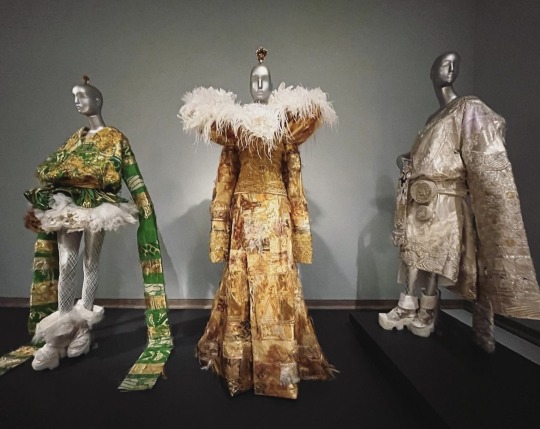
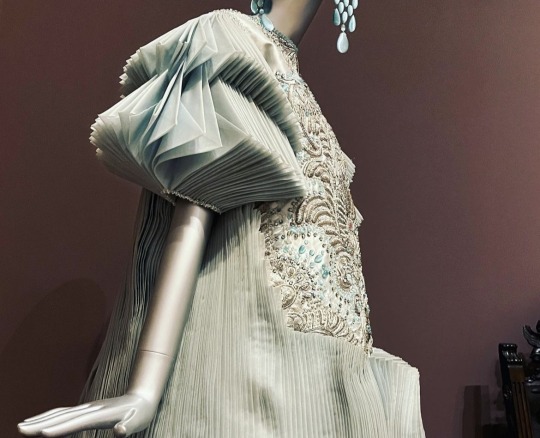
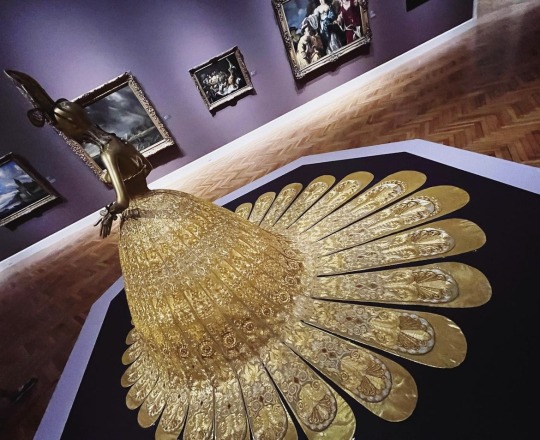
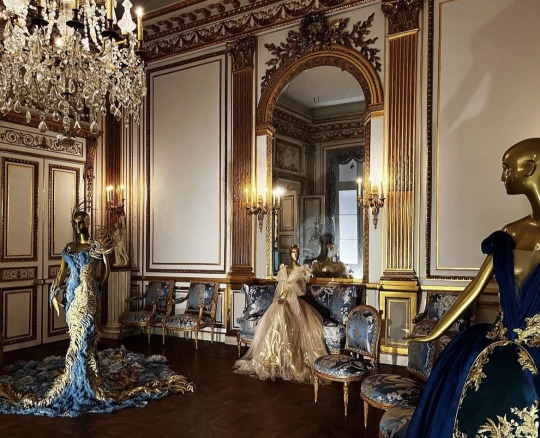
San Francisco's Legion of Honneur museum offers a dazzling selection of Guo Pei’s magnificent haute couture gowns created from 2006 to the present. Considered to be the first Chinese haute couturier, Guo Pei grew up during the Chinese Cultural Revolution, a tumultuous period where anything belonging to China’s Imperial past - traditions, script, literature, arts and antiquities, family histories and property - were all forbidden or destroyed. With an inexhaustible vocabulary of traditional motifs (lotus, Buddha, dragon, lilies, peacocks) woven onto sumptuous gold thread, “Guo Pei creates a fantasy that fuses the influences of China’s imperial past, decorative arts, European architecture, and the botanical world.” As imposing as the garments are, they also seem to poke fun at the spiritual and cultural weight of couture and Chinese traditional values. In several of her architecture series pieces, she uses bamboo strips, a material usually used as throwaway building scaffolding, in constructing Edwardian-style hoop skirts with boned corsets. In another couple of pieces from the same collection, she references Gothic cathedrals in monochrome embroidery on silk gauze: One can see pointed arches, flying buttresses, and stained glass sections placed where the wearer’s chest would be. Formerly reserved by law for the royal court, yellow silk dragons make their appearance time and again over gowns, deconstructed epaulets, even chaps held up by gold ribbons.
11 notes
·
View notes
Text
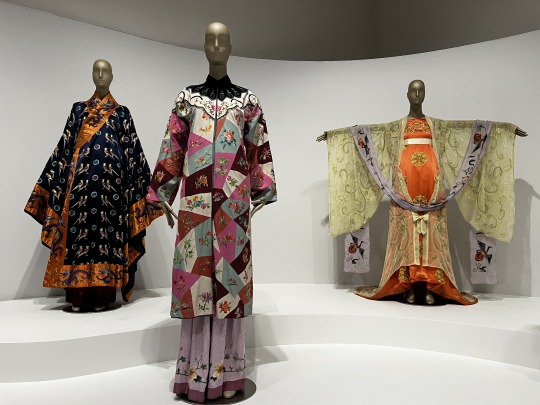
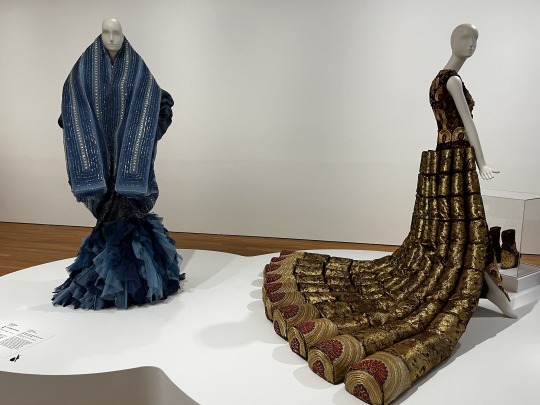
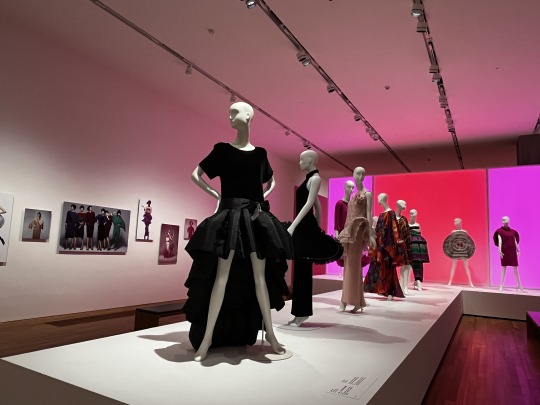
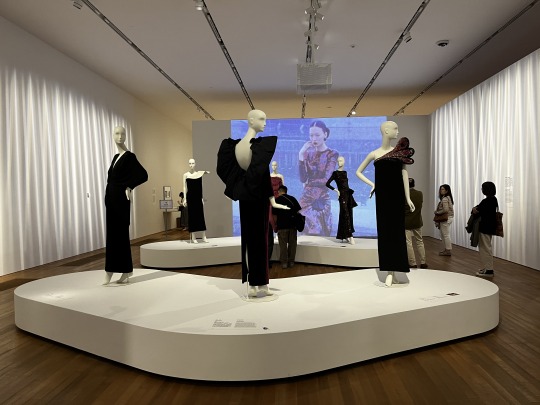
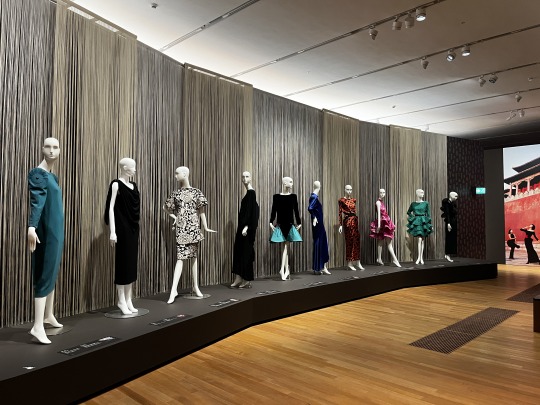
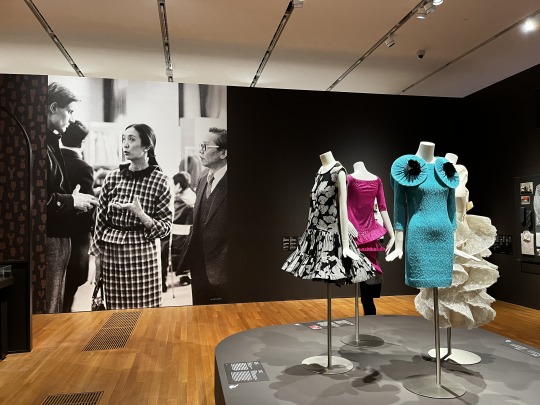
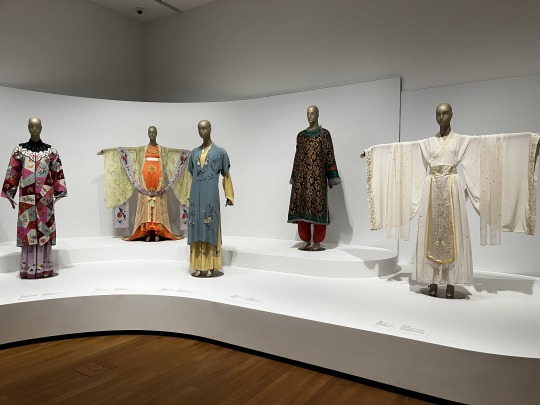
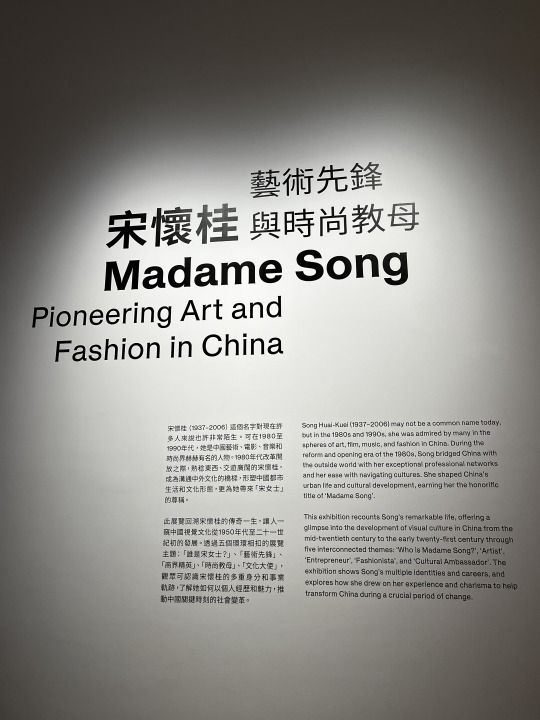
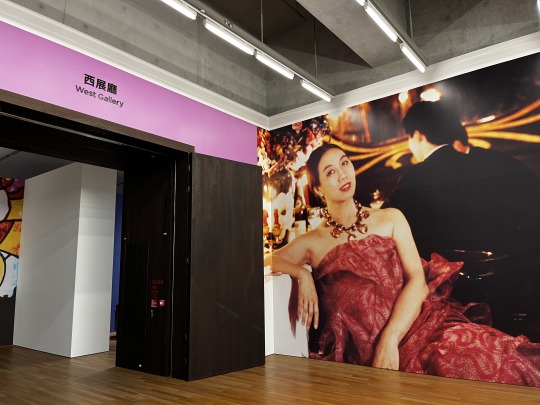
The pioneering party girl with a razor-sharp business acumen, the first of her kind in post-Revolutionary China, Madame Song continues to dazzle from beyond the ether at M+ museum in Hong Kong! A retrospective of the artist, model, restauranteur and Pierre Cardin muse Song Huai-Kuei (1937-2006) follows her journey from being a textile artist to opening the first Chinese outpost of the Parisian restaurant Maxim’s in Beijing, to becoming the representative of Pierre Cardin and bringing the world of modeling and French runway fashion to China on the first waves of post-revolutionary economic growth. Among her crowd were silver screen luminaries of her day; the 80's and 90's Hong Kong cinema stars, sprinkled with a good amount of French and Italian fashion designers. She was an outlier in an era of post-Revolutionary Communist and Socialist androgynous dressing, when both men and women wore genderless Mao-style workwear suits for day and night. She brought glamour, sex appeal, and some Parisian flair to the grey streets of Beijing when it needed color the most.
4 notes
·
View notes
Text

Asia Society’s exhibition: “Meiji Modern: 50 years of new Japan”, comprising over 80 works, including paintings, prints, photographs, sculptural works, and objects in various media, such as enamel, lacquer, embroidery, and textiles—is not to be missed under any circumstance! This exhibition presents some of the finest examples of Meiji-period artworks in American collections, both public and private, and masterfully weaves together different threads of historical narratives to create a tapestry reflecting a beautiful mosaic of Japnaese history.
"Japan’s Meiji Period (1868-1912) marked a period of drastic transformation to Japanese society, the economy, military, education, gender roles, and much more. At the center of this transformation was Japanese art and craft, which re-imagined traditional Japanese motifs and themes, simultaneously showcasing the country’s storied past and its thoroughly modern present, as the feudal shogunate moved toward constitutional monarchy. The artwork of the Meiji Period, as both artistic and technological achievement, is unrivaled in its intricate detail, technical mastery, precious materials, and inventive adaptation.”
Meiji Modern at Asia Society runs from 03 October 2023 - 07 January 2024.
1 note
·
View note
Text




“Liminal Air Space—Time: Vacuum Fluctuation” by Shinji Ohmaki at National Arts Museum, Tokyo. Elegant and mysterious, these shimmering nearly-invisible silk panels ripple outward toward the viewers in a cavernous light-less room, save for a set of square ceiling lights. One’s senses adjust to an awareness of void. A low mechanical hum that crescendoes into an eerie drone is the only sound accompanying periodic whooshing from the vacuums. As some areas of the waves crest, other sections collapse, immitating sound waves when visibly measured. Over the course of a meditative hour, I thought of ghostly apparitions, phantasms of light and shadow that glimmer momentarily on our minds only to melt back into an abyss. Ghost traces of past tsunamis, threatening to engulf all we see under colossal waves. Sacred light canopies, mystic veils offering psychic relief.
0 notes
Text
Ringing in the new year at the Western Buddhist Temple 寺方西 in Hong Kong with the royal family of Bhutan: Princess Ashi Sonam Dechen Wangchuck, Queen Mother Dorji Wangmo, and Crown Prince Jigme Namgyel Wangchuck! Prince Jigme practices his Mandarin studiously every day so that he can read masterworks of Buddhist texts. During this special meeting, Prince Jigme rung the oldest and largest bell of the monastery, chanted sections of the Heart Sutra with the head monk, sat for tea, then had lunch with notable monks of the monastery. Warm wishes for peace, love, and gratitude were meditated upon for all of humanity.
2 notes
·
View notes
Photo

Interview with photographer Ren Hang for Purple Magazine, S/S 2014
At 26, Ren Hang has already published six photography books, continually trumping conservative Chinese culture with his use of the nude. In a country where censorship extends to all aspects of life, Ren brings a dose of innocence to the task of irreverently awakening Chinese sexuality.
YANYAN HUANG — What did you start photographing first? REN HANG — Everything I saw around me. Friends, nature, places. I’m still photographing these things now.
YANYAN HUANG — Do you look to Western or Eastern culture for inspiration? REN HANG — Mostly Chinese culture.
YANYAN HUANG — Which artists are you looking at these days? REN HANG — My favorite one is the Japanese avant-garde director and photographer Shuji Terayama. He studied with Nobuyoshi Araki.
YANYAN HUANG — What kind of cameras do you like to use? REN HANG — I use multiple versions of a Minolta 35 mm film camera. Though I’ve experimented with all kinds of cameras, this model is my favorite. I found it through friends, who told me it was easy to use. I have five, since I break them easily.
YANYAN HUANG — How do you like living in Beijing? REN HANG — I live here because I went to school here, and since graduating I’ve just stayed. I like to see rock shows at little venues like Yugong Yishan and D22.
YANYAN HUANG — What are you working on now? REN HANG — I’ll be going to Paris in January to exhibit some work. Also, I’ll be photographing on set for the writer Ming Ming’s upcoming film.
YANYAN HUANG — Is it hard to be a photographer in China? REN HANG — No, it’s rather easy, but it is very difficult to shoot nudes in China. People are more bound by traditional and conservative attitudes toward the body. They think it’s a degradation, even a demoralization, to show what they think should be private. They generally abhor nudity here. We hide the body in our culture. In China, people will tell the government to shut down art and photography shows if there’s nudity. If you put nudes online, they don’t care about the composition, beauty, lighting, or artistic tradition — all they care about is that it’s a nude body and should not be seen.
YANYAN HUANG — What draws you to the body? REN HANG — I don’t really have an explanation. The way I see it, bodies are pre-existing regardless of whether I photograph them or not. They’re also part of the natural world.
YANYAN HUANG — Since depicting nudes isn’t acceptable in Chinese culture, how did you begin shooting them? REN HANG — I started shooting nudes only accidentally. In school, we were living in cramped dorm rooms of four people, so I would frequently see my roommates in the nude. It was a natural and easy subject because I was shooting everything anyway.
YANYAN HUANG — How do you construct a photo shoot REN HANG — It’s spontaneous for me. I don’t plan shoots, and I take photos whenever I feel like it. It’s like satisfying a thirst. I wait for natural moments of beauty, almost like stumbling upon them. I wait for ideas and plans that I’ve collected in my head to appear in reality.
YANYAN HUANG — Though your photos have a lot of sexual elements, they still seem quite innocent. Does this innocence reflect your relationship with your subjects? REN HANG — My models are all my friends. I haven’t photographed people actually having sex, but my friends trust me to use them as pliable tools. My friends are my collaborators. They trust me to control them and they submit willingly. Through my photos I would like people to have fantasies, to be seduced into conjuring up their personal sexual experiences.
YANYAN HUANG — What seduces you? REN HANG — Everything. If I want to think about sex, everything will conjure up a sexual thought.
7 notes
·
View notes
Photo

Photo diary from Art Basel Switzerland 2014 for Purple Magazine
0 notes
Photo
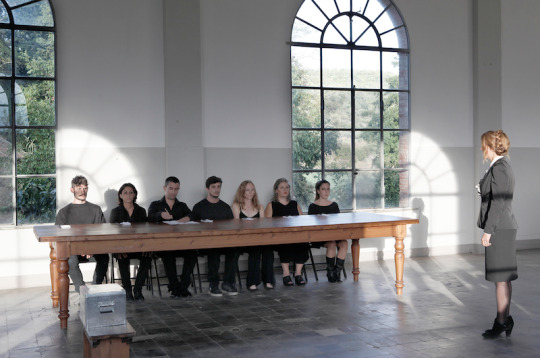
Residency Spotlight: Made in Filandia, Pergine Valdarno
Made in Filandia is a unique mix of an artist's residency, exhibition/project space, and art center. Flanked by vineyards and crumbling barns in the Italian countryside of Pergine Valdarno, artists Luca Pancrazzi and Elena el Asmar host visiting artists in the giant second-floor studio within the main building, work in their own studios on the second floor of their open-plan living space, and throw summer parties for friends and supporters to fund their annual October Made in Filandia event.
Thirty artists will stay at the renovated factory and create work based on the surrounding landscape, ranging from performances to permanent land art. They will also each make prints to be sold during the event.
http://www.madeinfilandia.org/
0 notes